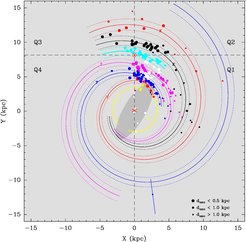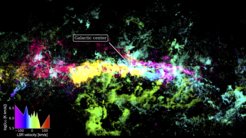The Milky Way
Large scale surveys of our Milky Way are one of the main topics of the group to reveal the structure of our own Galaxy and the properties of its dense interstellar medium as raw material for star formation. We conducted several legacy survey projects, the Global view on Star formation in the Milky Way (GLOSTAR) with the Very Large Array, the BeSSeL Survey (Bar and Spiral Structure Legacy Survey), as well as the APEX telescope surveys of dust and molecular gas, ATLASGAL and SEDIGISM.
GLOSTAR

The Global view on Star formation in the Milky Way (GLOSTAR) survey uses the wideband (4-8 GHz) C-band receivers of the VLA and the Effelsberg 100-m telescope to conduct an unbiased survey to characterize star-forming regions in the Milky Way. This survey of the Galactic mid-plane detects tell-tale tracers of early phases of high-mass star formation: compact, ultra- and hyper-compact HII regions, and 6.7 GHz methanol (CH3OH) masers, which trace some of the earliest evolutionary stages in the formation of high-mass stars and can be used to pinpoint the positions of very young stellar objects, many of them still deeply embedded in their natal material. The observations center at 5.8 GHz and also cover emission from the 4.8 GHz formaldehyde (H2CO) and multiple Radio Recombination Lines (RRLs), all of which will be presented in future publications. The GLOSTAR observations were made with the VLA B- and D-configurations and the Effelsberg 100-m telescope for the large scale structure.
Links:
The BeSSeL Survey

The BeSSeL Survey (Bar and Spiral Structure Legacy Survey) is a VLBA Key Science project. The survey is named in honor of Friedrich Willhelm Bessel who measured the first stellar parallax in 1838. The goal of the survey is to study the spiral structure and kinematics of the Milky Way. We will accomplish this by determining distances, via trigonometric parallax, and proper motions of star forming regions in the Milky Way. The target sources are methanol and water masers that are associated with young massive stars and compact HII regions that trace spiral structure. With accurate distance measurements we will locate spiral arms, and with absolute proper motions we can determine the 3-dimensional motions of these massive young stars.
The BeSSeL Survey is measuring accurate distances and proper motions of high mass star forming regions across the Milky Way. Using the VLBA we have measured about 150 trigonometric parallaxes. A similar program in the southern hemisphere, the "BeSSeL Survey South", is being organized. This will result in a catalogue of accurate distances to Galactic high mass star forming regions across the Milky Way. Modeling the absolute proper motions gives very accurate measurements of fundamental Galactic parameters, such as the distance to the Galactic center (Ro), the rotation velocity at the Sun (Θo), and the rotation curve of the Milky Way.
Links:
SEDIGISM

The SEDIGISM (Structure, Excitation and Dynamics of the Inner Galactic Interstellar Medium) survey is a large APEX spectroscopic project that used almost 800 hours of telescope time to observe 84 deg2 of the inner Galactic disc (-60 < l < 18 deg, |b| < 0.5 deg). The survey targets mainly the 13CO(2-1) and C18O(2-1) transitions, which have a much lower optical depth than that of the more commonly observed 12CO(1-0) transition. Therefore, they are well suited to trace the moderately dense (n ~ 103 cm-3) molecular gas in the Galactic ISM. The data also cover transitions from other molecules (H2CO, CH3OH, SO, SO2 , HNCO, HC3N, SiO), typically found in higher density regions, and can be used to probe their physical conditions. SEDIGISM aims to fully characterize the interstellar medium and the molecular gas structures in the inner Galaxy (like clouds, clumps, and filaments), from the point of view of their distribution, excitation, morphology, dynamics, and star-formation properties. Additionally, it will give new insights into the large-scale structure of the Milky Way, such as the nature of its spiral arms, bar, and the physics of the Galactic center.
Links:
- SEDIGISM website
- Press release, "An astonishing new three-dimensional view of the dense interstellar gas in our Milky Way"


